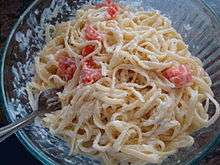Fettuccine Alfredo
 | |
| Course | Primo |
|---|---|
| Place of origin | Italy |
| Region or state | Lazio |
| Associated national cuisine | United States |
| Creator | Alfredo di Lelio I (1882–1959) |
| Main ingredients | fettuccine, Parmigiano-Reggiano cheese, butter |
| Variations | (in the US) broccoli, cream, parsley, garlic, chicken, shrimp |
|
| |
Fettuccine Alfredo (Italian pronunciation: [fettut'tʃiːne alˈfreːdo])[1] or fettuccine al burro is a pasta dish made from fettuccine tossed with Parmesan cheese and butter.[2][3][4] As the cheese melts, it emulsifies the liquids to form a smooth and rich coating on the pasta.[2] In other words, it is pasta with butter and Parmesan cheese (Italian: pasta al burro e parmigiano), one of the oldest and simplest ways to prepare pasta. Alfredo Di Lelio gave it this name at his restaurants in Rome, in the early to mid 20th century.[2][5]
History
Fettuccine with butter and Parmesan cheese was first mentioned in the 15th-century cookbook, Libro de arte coquinaria, written by Martino da Como, a northern Italian cook active in Rome.[6]
Alfredo Di Lelio invented the "fettuccine al triplo burro"[2] (later named "fettuccine all'Alfredo" or "fettuccine Alfredo") in 1892 in a restaurant run by his mother Angelina in piazza Rosa in Rome (the Piazza disappeared in 1910 following the construction of the Galleria Colonna/Sordi). Alfredo di Lelio later opened his own restaurant "Alfredo" in 1914 on the via della Scrofa in central Rome. The fame of "fettuccine all'Alfredo" spread, first in Rome and then to other countries. In 1943, during the war, Di Lelio sold the restaurant to two of his waiters.[7] In 1950, with his son Armando, Alfredo Di Lelio opened a new restaurant in piazza Augusto Imperatore, Alfredo all'Augusteo, now managed by his niece Ines Di Lelio, along with the famous "gold cutlery"[2] said to have been donated in 1927 by the American actors Mary Pickford and Douglas Fairbanks (in gratitude for Alfredo’s hospitality). The two restaurants compete vigorously, with escalating puffery: "the king of fettuccine", "the real king of fettuccine", "the magician of fettuccine", "the emperor of fettuccine", "the real Alfredo", etc.[7]
The dish was so well known that Di Lelio was invited to demonstrate it both in Italy and abroad.[7] The fame of the dish, called on Alfredo's menus "maestosissime fettuccine all'Alfredo" 'most majestic fettuccine, Alfredo style', comes largely from the "spectacle reminiscent of grand opera" of its preparation at table,[3] as described in 1967:
[The fettuccine] are seasoned with plenty of butter and fat parmesan, not aged, so that, in a ritual of extraordinary theatricality, the owner mixes the pasta and lifts it high to serve it, the white threads of cheese gilded with butter and the bright yellow of the ribbons of egg pasta offering an eyeful for the customer; at the end of the ceremony, the guest of honor is presented the golden cutlery and the serving dish, where the blond fettuccine roll around in the pale gold of the seasonings. It's worth seeing the whole ceremony. The owner, son of old Alfredo and looking exactly like him, ... bends over the great skein of fettuccine, fixes it intensely, his eyes half-closed, and dives into mixing it, waving the golden cutlery with grand gestures, like an orchestra conductor, with his sinister upwards-pointing twirled moustache dancing up and down, pinkies in the air, a rapt gaze, flailing elbows.[7]
Fettuccine Alfredo, minus the spectacle, has now become ubiquitous in Italian-style restaurants in the United States and internationally, although in Italy this dish is usually called simply "fettuccine al burro".[4][8]
Alfredo sauce
Alfredo sauce is often sold as a convenience food in many grocery stores in the United States. Unlike the original preparation, which is thickened only by cheese, the prepared food and fast food[9] versions may be thickened with eggs or starch. Alfredo sauce may also include cream.
See also
References
- ↑ "fettuccine" at Collins Dictionary, accessed 2016-11-22 (archive)
- 1 2 3 4 5 Carnacina (1975), p. 72–73
- 1 2 Waverly Root, The Food of Italy, 1971, p. 86
- 1 2 "Fettuccine Alfredo". Giallo Zafferano. Retrieved 2 April 2014.
- ↑ Downie, David (2011). Cooking the Roman Way. HarperCollins. p. 106. ISBN 9780062031099.
- ↑ de Rossi, Martino. Libro de Arte Coquinaria. pp. sub vocem.
- 1 2 3 4 'frasi' [pseudo. of Francesco Simoncini], Ristoranti a Roma, A.B.E.T.E. 1967, p. 99
- ↑ Bastianich, Lidia; John, Mariani. How Italian Food conquered the World (1st ed.).
- ↑ Papa Gino's, "Nutritional information and Allergens
Sources
- Carnacina, Luigi; Buonassisi, Vincenzo (1975). Roma in Cucina (in Italian). Milano: Giunti Martello.
External links
| Wikibooks Cookbook has a recipe/module on |